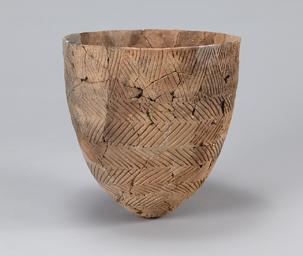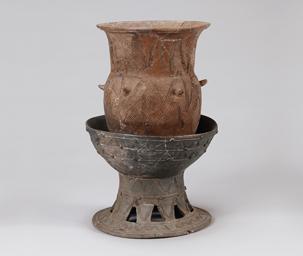
- Life of the Paleolithic, Neolithic, and Bronze Ages in Jeonbuk and the dolmen in Gochang and Jinan “The Beginning of Jeonbuk Prehistoric Culture”
- “Mahan, and its beginning,” which laid the foundation for an ancient nation by introducing a new ironware culture following the Bronze Age.
- The “Mahan to Baekje” corner contains the meeting between Mahan and Baekje, with independent powers.
- The ruins of Jukmak-dong, Buan, a maritime ritual site, and the “Jeonbuk, a buffer area of the Ancient State” contains the meeting among Gaya, Baekje and Silla
- The “Baekje Revival and Post-Baekje” corner contains the Baekje revival movement, the unified Silla’s Jeonbuk, and the Gyeon-Hwon’s post-Baekje.
The beginning of Jeonbuk prehistoric culture
Exhibition room
The 'Beginning of Jeonbuk Prehistoric Culture' corner presents new artifacts from the Paleolithic and Neolithic periods. Paleolithic tools identified in various areas such as the Seomjin River, Gunsan, and Gochang, surrounding Imsil, where a large number of Paleolithic relics are distributed, were exhibited in an easy-to-understand manner. In addition, you can see the lives of people in the Neolithic era in Jeollabuk-do, who were able to eat a variety of foods in various regions through earthenware, fishing hooks, grinding stones, and grinding plates. In addition, dolmen, a characteristic tomb of the Bronze Age, where full-scale farming began, and grinded stone knives and red earthenware identified therein were also exhibited. In particular, by exhibiting burial items such as grinded stone knives and grinded arrowheads identified in the area of Yongdam Dam in Jinan and the dolmen in Gochang, which are registered as a World Heritage Site, you will be able to understand the funeral culture of the people of the Bronze Age in Jeollabuk-do and the characteristics of the group.
Representative artifact
Mahan, its beginning
Exhibition room
In the corner of ‘Mahan, its Beginning’, you can see the Korean-style bronze sword culture that was further developed based on the ironware and bronze ware culture of the previous period, which appeared under the influence of the Yan Dynasty in China from around the 2nd century BC. In the Jeonbuk region, there are more tombs with bronze and ironware than any other region. In particular, the fine-pattern mirrors excavated from the Jeonbuk innovation city such as the Wanju Sinpoong ruins, Korean-style bronze swords, and pole toothed drop were collected in one place to highlight Jeonbuk, the largest bronzeware excavation site in Korea. From the bronzeware that was deliberately broken, including fine-patterned mirrors engraved with detailed patterns, you can see that Jeonbuk had the idea of the time, advanced technology, and the power to leap to an ancient country. In addition, you can see Samhan's development as the ironware culture began in earnest and each regional group was gradually integrated. You can see the image of Mahan in Jeollabuk-do, which was further developed based on new iron tools through tools for making ironware excavated from the graveyard of Mahan, and a loop handle big knife.
Representative artifact
Turn the page!
From Mahan to Baekje
Exhibition room
In the corner of 'Mahan to Baekje', you can look at the Jeollabuk-do area before and after the incorporation to Baekje. Mahan in the Jeollabuk-do region maintained its own power, but in the 5th century, it began to be influenced by Baekje in earnest. However, it seems that the Mahan power, which still has a considerable stature, served as a window for foreign exchanges. Things that show above story are the gold-bronze decorative shoes excavated at Bongdeok-ri, Gochang. In particular, by revealing collective relics such as gold-bronze decorative shoes excavated from the graves of Bongdeok-ri, Gochang, hole jars decorated with small jars, and Chinese celadon jars, you can see firsthand the appearance of the Gochang Mahan powers that engaged in active exchanges with Baekje. In addition, artifacts excavated from Mireuk temple ruins, Jeseok temple ruins, and Twin tombs, including the ruins of Wanggung-ri in Iksan, believed to be the palace of King Mu (reigned 600~641CE), functioned as another center of Baekje during the Sabi period at the end of Baekje.
Representative artifact
Jeonbuk, a buffer of ancient countries
Exhibition room
“Jeonbuk, the buffer site of the ancient nation” introduces the remains of marine rituals in Jukmak-dong in Buan and Gaya in the eastern part of Jeonbuk. The Buan Jukmak-dong Ruins, located on the Byeonsan Peninsula protruding from the coast, has been a base for sea routes since ancient times and a place where rituals were offered to the sea gods for the safety of sailing. The rituals made by the Mahan powers from the late 3rd century developed into the national rites of Baekje in the 5th to the first half of the 6th century. Here, you can see that the relics of Baekje, Daegaya, Japanese and Chinese were excavated together, such that you may know an international maritime rite was held. In the exhibition room, about 330 major relics are exhibited, including various vessels used for rituals excavated from the ruins of Jukmak-dong in Buan, and bronze tiles with various functions and ironware. Through this, you can get a glimpse into the wishes of people at that time for abundance and well-being.
Sogaya appeared in the early 5th century and Daegaya appeared after the late 5th century in the eastern mountainous areas of the Jeollabuk-do region. In the exhibition room, Gaya's earthenware, weapons, and horse harnesses, as well as outstanding prestigious items such as chicken-head celadon and iron pots excavated from the Wolsan-ri ruins in Namwon, and Baekje and Silla pottery excavated from the Gaya tomb, are exhibited, such that the visitors may see the dynamic Gaya, Baekje and Silla. You can see the figure of dynamic Jeonbuk where Gaya, Baekje and Silla were fused.
Representative artifact
Turn the page!
Revival of Baekje and Hubaekje
Exhibition room
The corner of “Revival of Baekje and Hubaekje,” illuminated Jeonju, the capital of Hubaekje since 660. Hubaekje laid the foundation for the country centering on Mujinju (today's Gwangju) in 892, the end of the Unified Silla, and then moved the capital to Jeonju in 900 and designated the national name as Hubaekje. Relics excavated from Maro Fortress in Gwangyang and Mujingo Castle in Gwangju were exhibited to illuminate the early days of Hubaekje. In addition, tiles excavated from Donggo Fortress in Jeonju, with the words of 'Jeonju castle' stamped on it, and a rubbed copy of 'Jeonggae', the original name of Hubaekje, engraved on the Pyunwoonwhasang stone stupa of Namwon Silsangsa Temple, formed a powerful country for 37 years among the latter three countries, such that the visitor may firsthand check the appearance of Hubaekje.
Representative artifact

The beginning of Jeonbuk prehistoric culture
- 101Tanged Points
- 102Comb-patterned Pottery
- 103Farming Tools
- 104Bronze Mirror with Coarse Linear Design
- 105Polished Stone Daggers
- 106Mold, Korean Style Bronze Dagger, Mirror with Fine Linear Design, Beads
Mahan, its beginning
- 107Bronze Mirror
- 108Artifacts Excavated from the Archaeological Sites in Gal-dong, Wanju
- 109Smithy Tools
- 110Cylindrical Pottery
Jeonbuk, a buffer of ancient countries
- 111Vessel Stand
- 112Helmet, Gorget, and Scale Armor
- 113Celadon Jar with a Rooster Head Decoration
- 114Mounted Jar With Long Neck
From Mahan to Baekje
- 115Gilt-bronze Decorated Shoes
- 116Gilt-bronze Cowl Cap
- 117Long-necked Jar
Revival of Baekje and Hubaekje
- 118Roof Tile with the Inscription of “Capital and Roof Tile with the Inscription of "Central Region"
- 119Iron Saucer
- 120Roof Tile with the Inscription of “Geummajeoseong Fortress"
- 121Roof Tile with the Inscription of “Jeonjuseong Fortress"
QUICK MENU 원하시는 서비스를 클릭하세요!
등록된 퀵메뉴가 없습니다.























